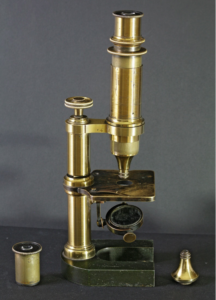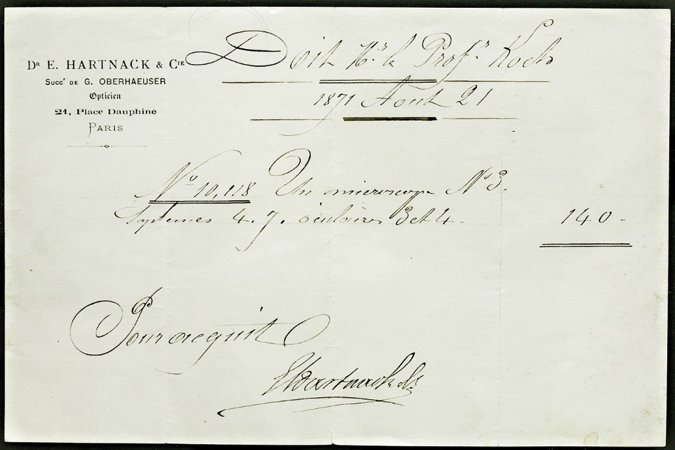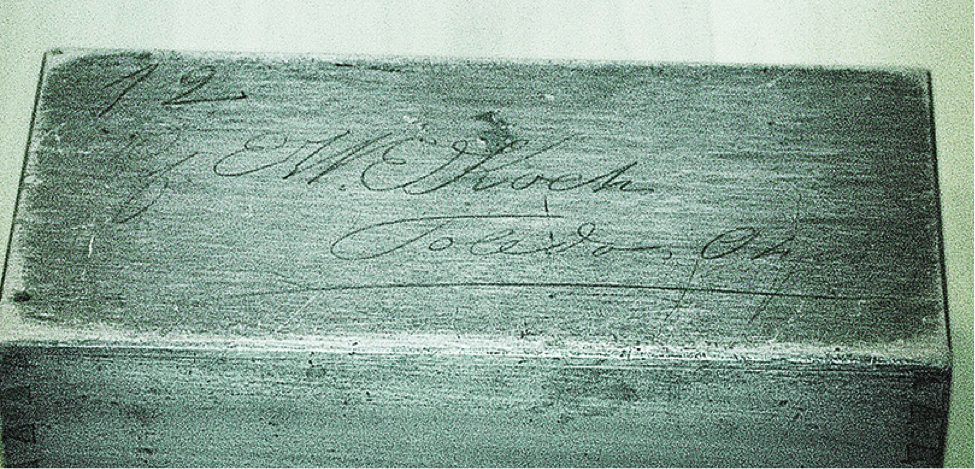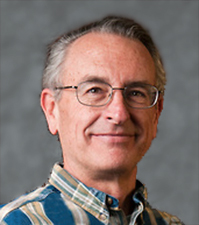 Our family has an historic heirloom, a microscope that originally belonged to [Heinrich Hermann] Robert Koch (1843-1910), the famous German bacteriologist, who won the 1905 Nobel Prize in Physiology and Medicine for his discoveries related to the causative agents of anthrax, tuberculosis, and cholera. The microscope came into our family by virtue of his cousin, my great-great-grandfather, Ernest Wilhelm Eduard Koch (1827-1903), who was born in Braunschweig (Brunswick), Germany, about 30 miles from Clausthal, the birthplace of Robert Koch. After moving to the United States, great-great-grandfather went by “Edward,” but usually was referred to by the family as E.W.E.
Our family has an historic heirloom, a microscope that originally belonged to [Heinrich Hermann] Robert Koch (1843-1910), the famous German bacteriologist, who won the 1905 Nobel Prize in Physiology and Medicine for his discoveries related to the causative agents of anthrax, tuberculosis, and cholera. The microscope came into our family by virtue of his cousin, my great-great-grandfather, Ernest Wilhelm Eduard Koch (1827-1903), who was born in Braunschweig (Brunswick), Germany, about 30 miles from Clausthal, the birthplace of Robert Koch. After moving to the United States, great-great-grandfather went by “Edward,” but usually was referred to by the family as E.W.E.
E.W.E. was a highly educated man and was an “1848er,” one of many who emigrated from Germany after the 1848-49 revolutions there. E.W.E. became an educator in the Toledo, Ohio school system, where he began the instruction of foreign languages, taught art and the German language, and introduced gymnastics into school curricula. (He was a member of the Turnverein movement in the U.S.[i]) He eventually became Superintendent of Schools in Toledo. Later he was elected, with the title of professor, to the faculty of the Agricultural and Mechanical College of Kentucky University (later University of Kentucky).
After his death, the microscope went to one of his daughters, my great-grandmother Bertha (Koch) Feist. Bertha was born in 1868, and early in her life arrived in Aspen, Colorado, in a horse-drawn carriage. She died at age 101, a longevity that allowed her to experience many developments unimaginable at her birth – the automobile, the telephone, radio, television, airplanes, and humans going to the moon. What a perspective on technological advance she must have had. A fond memory I have of her is being sent out behind her house to fetch a pail of coal for her kitchen stove. True to her name, she was a great cook, and she used a coal-burning stove all of her life.
The microscope was then passed down to the generations that followed. And it moved around a bit, staying with one relative or another, until finally it ended up with one of my cousins.
The problem
A few years ago he contacted me about selling the microscope to a museum. Better it should be there than in someone’s closet, he opined, and all the cousins could share the in the proceeds. We reckoned that something like that should be worth tens of thousands of dollars. And, by the way, he said to me, you are the best person to take care of making this happen. Well, thanks, I think.
Not knowing quite how to proceed, I decided on two courses of action: determine its value and make a solid case for its provenance.
I got in touch with a microscope collector who gave me the address of a New York auction house dealing in scientific equipment. They gave me an informal appraisal, based on a photo and the background information. The value was estimated to be around $500. Oh. But with a photo of Robert Koch using it, the value would be a bit more, especially if we could get two interested museums going to battle over it. Still, in their words, it would be “a tough sell.” So much for its value.
On to provenance. What did we know? E.W.E., the first in our family to possess the microscope, was, according to another of his daughters, a cousin of Robert Koch. The scope has not left our family since he was in possession of it. Also, we have the actual receipt for the purchase of the microscope: sold in 1871 to Mr le Prof r Koch by Dr E. Hartnack & Cie, 21 Place Dauphine, Paris. Hartnack was known at that time as a maker of quality microscopes. The serial number on the receipt matches the serial number on the microscope. We also know that Robert Koch’s first microscope was a Hartnack microscope,[ii] purchased for him as a birthday present by his wife, sometime in the early 1870s. While not entirely sufficient, this information seemed a solid base from which to proceed.
On to provenance. What did we know?
My next step was to firm up and expand on this information. It seemed to me that it would be important to prove the relationship of E.W.E. to Robert Koch. What followed then can only be summarized in that simple phrase: “When the end comes, it comes quickly.”
A family member’s search at Ancestry.com had shown a connection between E.W.E. and Robert Koch. However, it turned out that this connection was found in someone’s online family tree and there was no source given. And I couldn’t find any. A book that examined the genealogy of Robert Koch’s family[iii] provided no evidence of a connection between E.W.E. and the extended Robert Koch family. The Museum at the Robert Koch Institute in Berlin was consulted and they could find no connection. They even contacted a Robert Koch descendant who has studied his family’s history, and he found no connection.
The coup de grâce came from E.W.E. himself in a recently unearthed document written by him, where he states: “Grandfather came to Brunswick from near Clausthal in the Harz Mountains where other members of his family resided and whence a young man August Koch, the probable uncle or father of Dr. Koch of Berlin, came to study at the Brunswick Gym and the Collegium Carolinum. We called one another cousins.” Firstly, Robert Koch’s father had the name Hermann, and none of his uncles had the name August. Secondly, “probable” and “we called one another cousins” do not firmly establish a family connection. In the recollections of one of his daughters, these words did established one, and she wrote as much in a letter to her daughter. This seems to be the source of the notion that E.W.E. was a cousin of Robert Koch.
But even so, we have the purchase receipt for a Hartnack scope sold to Professor Koch close to the time Robert Koch is known to have obtained his. And the Robert Koch Institute Museum does not know the fate of his Hartnack microscope, the very one that started his career in bacteriology. Surely that is strong evidence. Unfortunately, the purchase receipt, that simple document so important to our case, contained three facts that, after further research, proved our total undoing.
First was the 1871 date. The Franco-Prussian war ended in January of 1871. Would Robert Koch’s wife travel to the recent enemy’s capital, which had experienced revolution after the war, to buy a microscope? Not to mention that, because of the war, Dr. Hartnack, a German, had left his Paris shop in the hands of a Polish employee and moved to Potsdam in Germany, where he opened another shop. Frau Koch could have more easily and safely purchased the microscope closer to home in Potsdam.
 Second, our receipt’s date of August of 1871 is at least eight months before Robert Koch is known to have obtained his first microscope, a Hartnack microscope.[iv]
Second, our receipt’s date of August of 1871 is at least eight months before Robert Koch is known to have obtained his first microscope, a Hartnack microscope.[iv]
Third, the name on the receipt is Profr Koch. When Robert Koch obtained his Hartnack microscope, he was a country medical doctor, not a professor. He was given the title of Professor of Hygiene in 1885 when he accepted a position in the Medical Faculty of the Friedrich-Wilhelm University in Berlin.[v] He would not have dared to use the superior title of professor any earlier than when he was given it in 1885.
To paraphrase Thomas Henry Huxley[vi]: Here we see the great tragedy of family history – the slaying of a beautiful story by an ugly set of facts. To paraphrase a family member – this was not welcome news.
Resolution
How does all of this make sense? Another document, somehow previously overlooked, provides almost all we needed to know. When E.W.E. Koch left Kentucky University at the end of a spring term, a regent of that university wrote him a letter of introduction and recommendation. Addressing him as Professor Koch he wrote: “He visits Europe and his native land for educational and scientific research, that he may be the more useful in this his adopted country, to which he has been ever intensely loyal and devoted.” The date? June 1871. Professor E.W.E. Koch himself went to Europe in the summer of 1871. He was “Mr le Prof r Koch” on the August receipt. He purchased the microscope!
 The final evidence, indirectly given by E.W.E. himself, was found on the much-worn bottom of the wooden microscope box, and was so difficult to see that only an infrared image revealed what had been inscribed there in pencil: ”Prof. E.W.E. Koch, Toledo, Ohio.”
The final evidence, indirectly given by E.W.E. himself, was found on the much-worn bottom of the wooden microscope box, and was so difficult to see that only an infrared image revealed what had been inscribed there in pencil: ”Prof. E.W.E. Koch, Toledo, Ohio.”
Where did we go wrong? Coincidences were plentiful. Here were two men with the same last name, both with the title of professor, born in a distant land sixteen years apart and 30 miles from each other. One of them hints at a family relationship to the other. Both men acquired a Hartnack microscope within eight months of each other. All of this was viewed through the fog of 140 years’ passage of time.
However, there is no doubt that the desire to connect our family to a famous person, and generations of family story telling à la the telephone game, led us down the rabbit hole. Well, except for me, the myth slayer. Along the way down, I was forced to take a detour straight to the dog house.
I wonder, should I examine my grandmother’s claim that her ancestors were related to Marie Antoinette? Better to heed Geoffrey Chaucer’s observation: “It is nought good a slepyng hound to wake.”
Notes
[i] Turnverein is from German “turnen,” to practice gymnastics, and “verein,” a club or union, and was started in Germany when it was under the rule of Napoleon. It was a movement that was political as well as athletic. In the U.S., the “Turners” were active in promoting gymnastics as a sport and its importance to academics: “Sound body – Sound Mind.”
[ii] Thomas D. Brock, Robert Koch, A Life in Medicine and Bacteriology (Washington, D.C.: ASM Press, 1999), 23.
[iii] Helmut Radday, . . . und geben unsere Auswanderung bekannt; Ein Beitrage zur Sozialgeschichte des Oberharzes im 19. Jahrhundert am Beispiel des Familienverbandes Koch (Clausthal-Zellerfeld, 2000).
[iv] Brock, Robert Koch, A Life in Medicine and Bacteriology, 21. Robert Koch moved to Wollstein, Germany (now Wolsztyn, Poland), in April 1872. Sometime after moving there, he obtained his Hartnack microscope.
[v] Brock, Robert Koch, A Life in Medicine and Bacteriology, 183.
[vi] “The great tragedy of science—the slaying of a beautiful hypothesis by an ugly fact.” Found in Michael Foster and E. Ray Lankester, eds., The Scientific Memoirs of Thomas Henry Huxley, 4 vols. (London, 1901), 3: 580.
Share this:

About Philip Grover
Philip Grover is a retired chemical engineer who got involved in genealogy by helping his mother enter her extensive family research into Personal Ancestral File for Mac. Little did he know then what a slippery slope that minor involvement would become. After getting deeply involved in doing his own research, he realized how disinterested family members can be in genealogical charts, lists, and diagrams. His focus since has been making his family history more interesting and accessible, and toward that end he has self-published three books of family history.View all posts by Philip Grover →